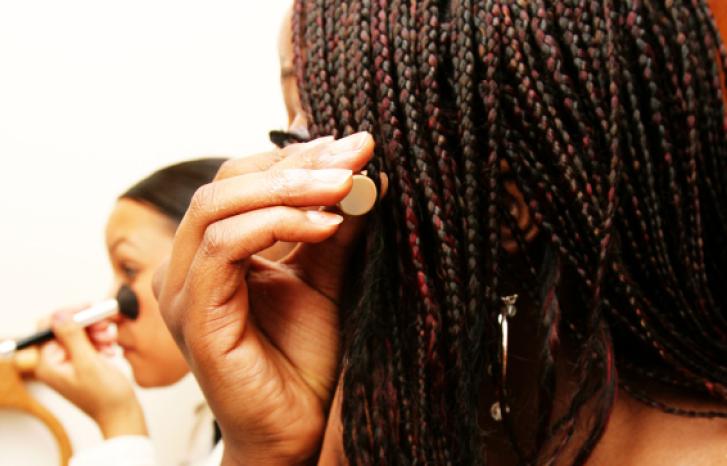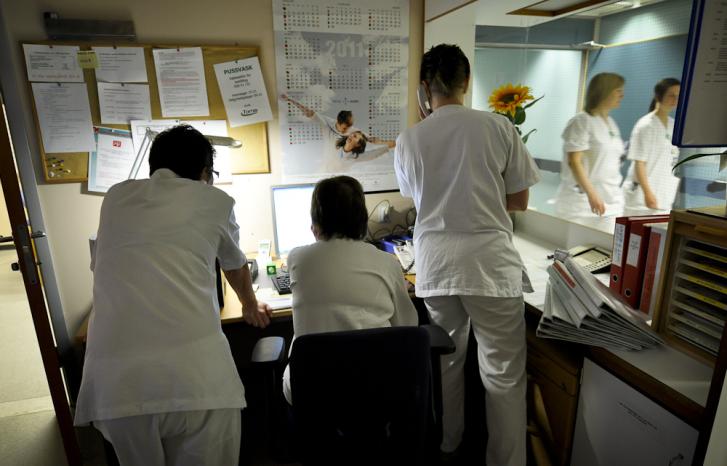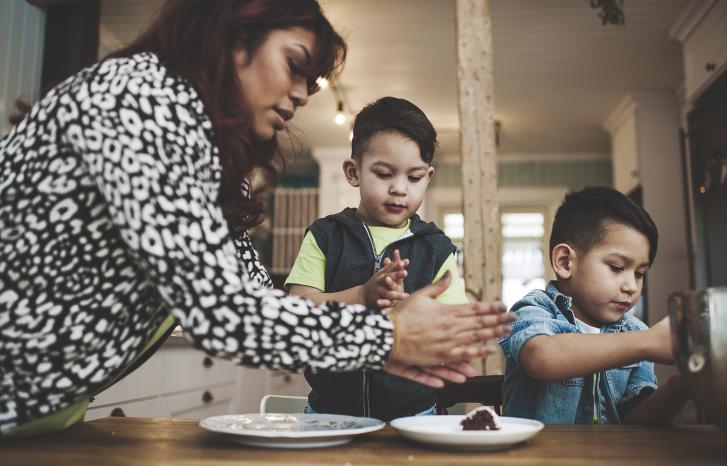In early February 2011, more than hundred Ethiopian protesters entered Oslo Cathedral to start a hunger strike. They had all had their application for political asylum rejected in Norway but claimed that the applications weren’t processed on an individual basis. They now feared being sent back to Ethiopia.
The hunger strike ended a week later, but the Ethiopians continued fighting for their cause by moving into a tent outside Oslo Cathedral.
“What characterised this group of so-called irregular immigrants was that many of them had lived in Norway for many years and spoke good Norwegian. Many of them had been working, for instance in the health sector, something that had been possible for them because they had tax deduction cards.”
“They did not have a legal right to live in Norway, but due to a system error and lack of communication between the immigration authorities and the Norwegian Tax Administration, they kept receiving tax deduction cards. This was now put an end to,” says Synnøve Bendixsen.
Children’s welfare disputed
She is a postdoctoral researcher at the Department of Social Anthropology at the University of Bergen. During winter and spring 2011, she conducted her fieldwork in Oslo, where she paid daily visits to the Ethiopian protesters.
There were several families in the tent outside Oslo Cathedral.
“The fact that there were families staying in the tent had probably been highlighted if they had been demonstrating in a local community surrounded by Norwegian activists. Now it was the opposite. They had chosen to demonstrate by putting up a tent in the middle of Oslo city. This is not a place for a family to live, and thus the protesters failed to get through with arguments saying that these were families with local roots in Norway,” says Synnøve Bendixsen.
The children’s welfare became an issue in Norwegian media in a way that upset and bothered the Ethiopian protesters.
“Many of the women with children felt that they had to defend themselves as mothers. Originally, when the hunger strike started, they argued for this as mothers, that it was part of their struggle to secure a future for them and their children. What they experienced was being labelled as irresponsible mothers by entering the church in order to hunger strike. This was something you just didn’t do as a good mother,” says Bendixsen.
“If you enter a church in order to hunger strike, this is considered highly extreme in Norway.”
“This is pure extortion, which doesn’t serve their cause at all. It is also child abuse,” said representative from the Progress Party Per Sandberg, who was a member of the Parliament’s Standing Committee on Justice at the time, in a news interview.

“You may bring your child to a peaceful protest march and still be a good mother. In fact, then you raise your child to become a good citizen. But if you enter a church in order to hunger strike, this is considered highly extreme in Norway. Involving your children in something like that, even if the children eat properly, it is not considered raising your child to become a god citizen. On the contrary: You appear as a risk parent. You expose your children to unnecessary risk, which is considered contrary to the definition of a good parent who is supposed to protect a child from every possible risk,” says Bendixsen.
See also: Raise their sons to become better men in order to ensure equal lives for their daughters
Paradoxical care
The media had a lot of focus on how the children were taken care of – by Norwegian humanitarian assistance.
“The press was very interested in whether the children were well taken care of, that there were nurses present and that they were looked after by the Norwegian welfare state.”
This appeared as a paradox for the Ethiopian protesters.
“To them, it was precisely the Norwegian state’s treatment of them as mothers that they considered a risk to their children. Because they didn’t get asylum in Norway they weren’t able to give their children the safe future they wanted for them.”
“As a mother, why choose hunger?”
According to Bendixsen, the public also underestimated the journey that many of the families had undertaken to come to Norway.
“Some of the children were born here while others had been on the journey to Norway. These had been involved in a far greater risk on their voyage to Norway than entering a church in which they ate, had a roof over their heads, and the situation was under control after all.”
During the winter in 2011, the Norwegian Centre against Racism organised a debate at the House of Literature in Oslo, where the Ethiopian’s situation was discussed. One of the women who had been involved in the hunger strike was interviewed on stage by a female minister who asked: “As a mother, why choose hunger?”
“I spoke to the woman immediately after, and the first thing she said to me was that she had tried to show that she really was a good mother. She felt so criticised. Following this, I noticed a change in how she and the other women with children had to present themselves – first as good mothers, then as political activists. In other words, these two dimensions of their lives were kept separate, which was the opposite of how they had originally thought of it.
See also: Queer asylum seekers should talk about romantic love
The children part of the situation
“It is possible that a white, Norwegian woman would have encountered some of the same criticism,” says Bendixsen.
“If you demonstrate publicly as a mother on behalf of your child, the way in which you’re perceived as mother becomes highly important in order to get your political message through. The space given to you as a political actor within the public sphere is probably far more gendered than what we’d like to think here in Norway, the model country of gender equality.”
In the aftermath of the hunger strike, many of the mothers emphasised that they had no family in the country who could have looked after the children anyway.
“The space given to you as a political actor within the public sphere is probably far more gendered than what we’d like to think here in Norway.”
“But the thought of sending the children away, or that that the children shouldn’t be involved, didn’t strike them in the first place. As one of them said: “The children are part of the risk situation in which we are put by the authorities, the situation we are demonstrating against. Why, then, should we exclude the children from the situation we’re trying to throw light on?”” says Bendixsen.
The Ethiopian men were met with other remonstrances.
“Black men are often considered a threat to women and children, as molesters. In the situation in question, the Ethiopian women were not portrayed as victims such as black women often are. They were probably too many and too active in the protest for that. But the children were portrayed as victims of both bad mothers and unreliable fathers.”
One of the Ethiopian men who were interviewed in the media criticised what he considered the authorities and media’s exaggerated focus on the children’s welfare.
“He believed that all this attention was a manoeuvre in order to delegitimise the adult protesters’ position as good and responsible human beings. He and many others thought that if they really wanted to help the children the authorities would have been there for them also after the media had left the scene. But according to him that didn’t happen.”
Forced to attract attention
The fact that the Ethiopian protesters sought the public’s attention might seem surprising to many. After all, they were illegal.
“When irregular immigrants are mentioned, they are often referred to as people living in hiding trying not to attract any attention, who just try to survive on the edges of society. In this situation, however, we witnessed the same as what we’ve seen in several occasions in other countries: The irregular immigrants get to a point where they feel that their situation has intensified to such a degree that they have more to lose by remaining invisible than by attracting attention,” says Bendixsen.
The Ethiopians also had a genuine belief that if the Norwegian citizens could only see how they were treated they would stand up against the authorities on the Ethiopians’ behalf.
“The protesters’ most important argument was that they had been in the country for so long, they had paid their taxes, and become part of the country. Some had bought or rented houses. They considered themselves Norwegian citizens, so why wouldn’t Norwegian authorities do the same?”
The tent outside Oslo Cathedral was ordered to be removed in June 2011, allegedly because of fire hazard.
Does society unravel as women pack up and leave?
No change in conditions
Bendixsen discusses the protest and how the women were met in particular in an article entitled “Can the Irregular Migrant Woman Speak?” It is a rhetorical question of course, based on the Indian born theorist and literary critic Gayatri Spivak’s just as rhetorical question “Can the subaltern speak?” Her response was no, not because the subalterns don’t have a voice but because they’re excluded from the channels in which they’re heard.
Bendixsen’s response to her own question is both yes and no.
“Yes, the irregular immigrant women can speak out and make themselves visible. But they have to speak about themselves in certain ways.”
“Some researchers have drawn attention to how irregular immigrants stir up our ideas of citizenship and thus change the boundaries for who may be included in the definition of the term and who are not. I think we see time and again that this is not the case, however. Irregular immigrants fail to challenge the boundaries. Instead, they’re forced to enter the category of good, potential citizen where they have to adjust the way in which they talk about themselves in order to make it fit the category.”
“Irregular immigrants fail to challenge the boundaries.”
Thus, the category defining what it means to be a legitimate citizen remains intact.
“So yes, irregular immigrant women can speak as long as it happens within their given framework. But they can’t expand the framework themselves in order to make it cover them as well.”
“Even though the Ethiopian women faced the criticism and tried to adjust to society’s demands of a good mother it didn’t help. They were and remained irregular immigrants.”
Source: Can the Irregular Migrant Woman Speak?, Synnøve Bendixsen in Gendered Citizenship and the Politics of Representation, Palgrave, 2016.
Translated by Cathinka Dahl Hambro


